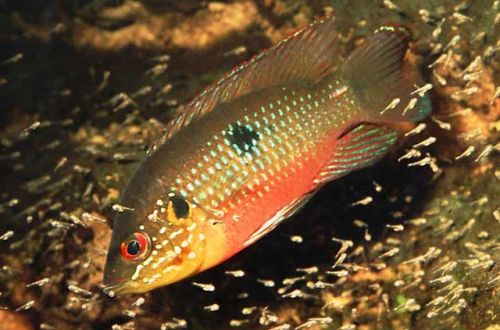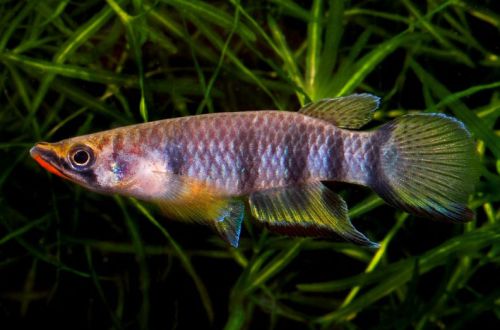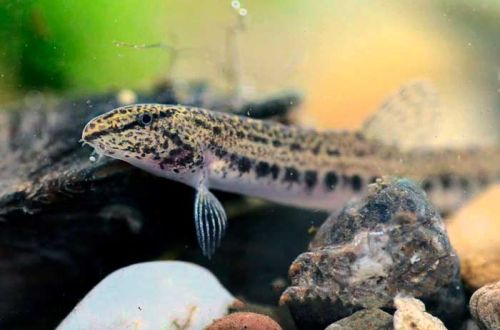
Chromis handsome
The handsome chromis, scientific name Hemichromis bimaculatus, belongs to the Cichlidae family. A beautiful bright, but equally dangerous fish for its neighbors in the aquarium. During spawning it becomes very aggressive. Not recommended for beginner aquarists, it is optimal for species aquariums when kept in pairs.

Habitat
It is widely distributed along the western coast of Africa from South Guinea to Central Liberia in the Niger, Congo, and Nile river systems. Inhabits shallow streams and canals in densely vegetated areas.
Requirements and conditions:
- The volume of the aquarium – from 110 liters.
- Temperature – 22-28°C
- Value pH — 6.0–7.0
- Water hardness – range from soft to medium hardness (4-12 GH)
- Substrate type – fine gravel
- Lighting – moderate
- Brackish water – no
- Water movement – moderate
- Size – up to 15 cm.
- Food – meat
Description

It has a high elongated body, the ends of the dorsal and anal fins are pointed, the caudal fin has a rounded shape. The coloration is carmine-red, especially intense in females during the mating season. The entire body and fins are covered with rows of light dots of a bluish tint. There are two dark spots: one near the head, the other in the center. The fins have dark edging.
Food
Mainly live food in the form of small fish, earthworms, insect larvae. It is acceptable, but undesirable, to serve dry and freeze-dried food, only as a supplement to the main diet. Herbal supplements are desirable, for example in the form of dried flakes.
Maintenance and care
Depending on the type of aquarium (species or general), its size will also depend. For a couple of fish, 110 liters is enough, for several fish, and even more so for different species, a much larger tank will be required. The design must have numerous shelters, in addition to decorative objects, ceramic pots, jugs, or just pieces of plastic pipes half buried in the ground will also come in handy. The substrate should be dense, rocky, Chromis-handsome likes to rummage in it, this in turn imposes restrictions on plants. Pick up large plants with a powerful root system and securely fasten them to the bottom.
Water is preferably slightly acidic soft or medium hardness. Read more about pH and dH parameters in the section “Hydrochemical composition of water”. It is recommended to update the soil weekly by 10-15% of the volume and clean the soil from the waste products of fish.
The equipment is standard and includes a filter, an aerator, a heater and a lighting system.
Behavior
A quarrelsome territorial fish, becomes extremely aggressive during spawning. The best option is to keep a male/female pair in a species aquarium. However, there is a risk of incompatibility here. Not all members of the opposite sex can become a couple. It is not uncommon for one of the Khromis to simply kill a weaker neighbor. Before you buy this beautiful fish, contact a professional breeder and order an already formed pair from him.
Breeding / breeding
In this species, a pair is formed for life, so if you have acquired it, then you can count on offspring. Spawning is stimulated by a good diet of live food, the establishment of slightly acidic water, closer to neutral pH values and a temperature of 26–27°C. When the male and female are ready to spawn, their coloring becomes the most vivid. It is this period that is most dangerous for other species if they live in an aquarium with Chromis.
The male prepares a place for laying, it can be any of the existing shelters, he cleans it and the adjacent territory from debris. Then he begins to energetically invite the female to him. If she is not ready, then such an active pursuit may even end in her death. Keep a close eye on them and, if necessary, put the female in a separate tank.
The female lays about 600 eggs, the incubation period lasts 24 hours. During this time, the male begins to guard duty and at the same time digs several holes in the ground. When the fry are born, they, together with the female, swim out of the shelter and move to one of the prepared pits. So they wander from one hole to another until the juveniles are old enough to live on their own, usually it takes about a month. After that, they are removed from their native aquarium to another.
Diseases
The main reasons for the poor health of fish include poor nutrition and unsuitable habitat. Such an unfriendly disposition can also cause physical injury. Read more about symptoms and treatments in the Aquarium Fish Diseases section.





